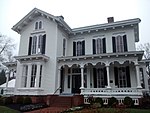Haywood Hall
Federal architecture in North CarolinaHaywood family residencesHistoric American Buildings Survey in North CarolinaHistoric district contributing properties in North CarolinaHistoric house museums in North Carolina ... and 9 more
Houses completed in 1792Houses in Raleigh, North CarolinaHouses on the National Register of Historic Places in North CarolinaMuseums in Raleigh, North CarolinaNRHP infobox with nocatNational Register of Historic Places in Raleigh, North CarolinaRaleigh, North Carolina Registered Historic Place stubsRaleigh, North Carolina building and structure stubsUse mdy dates from August 2023

Haywood Hall, also known as the Treasurer John Haywood House, is a historic home located at Raleigh, Wake County, North Carolina. It was built in 1792, and is a two-story, five-bay, Federal-style frame dwelling with a central hall plan. It features a two-story front porch with attenuated fluted Doric order columns. It was the home of North Carolina State Treasurer John Haywood (1754-1827). It is now open as a historic house museum. It was listed on the National Register of Historic Places in 1970. It is located in the Capitol Area Historic District.
Excerpt from the Wikipedia article Haywood Hall (License: CC BY-SA 3.0, Authors, Images).Haywood Hall
North Wilmington Street, Raleigh Seaboard Station
Geographical coordinates (GPS) Address Nearby Places Show on map
Geographical coordinates (GPS)
| Latitude | Longitude |
|---|---|
| N 35.785555555556 ° | E -78.638055555556 ° |
Address
North Wilmington Street 367
27601 Raleigh, Seaboard Station
North Carolina, United States
Open on Google Maps









